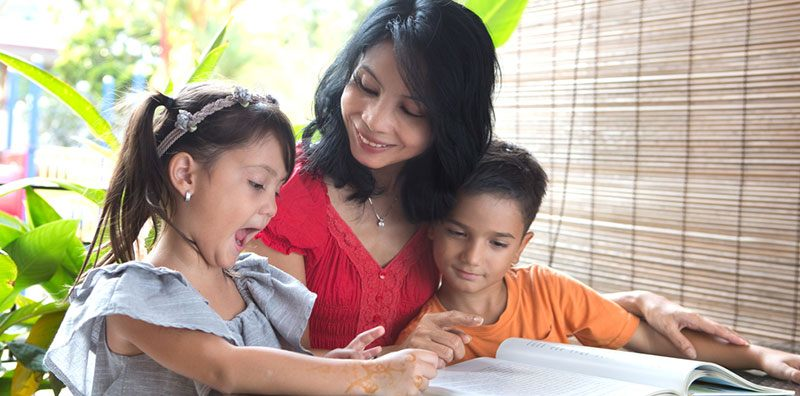How Environment Influences Child Personality
by on 02/08/2025 ...

We all want to raise a resilient child – tough and able to persevere even after facing constant failure. “But what if my child doesn’t have it in him?” you may ask. “What if he’s just not that way?” Have you ever wondered about environmental influences on personality? The answer may come as a surprise to some parents.
Being resilient is like being a rubber band.1 A rubber band is flexible. It can stretch well beyond its size, but afterwards it will return to its original shape. These are the qualities that we want our children to have: to be able to bounce back after any challenges or hardship, to be adaptable to change.
There is another interesting thing about our rubber band metaphor. Rubber in its original state isn’t flexible at all. It becomes the stretchy rubber band we know through a process called vulcanisation. The lesson? Children aren’t resilient from birth. It is something that can be taught and nurtured.
Environmental influences on personality

Parents have an important role in helping to build resilience for their children. Plenty of research on the effects of environmental influences on child personality, shows that who they are – or will be – isn’t defined from birth. It is their experiences growing up in their environment that plays a big part in shaping them into resilient individuals. And parents play a huge role in shaping this environment.
It’s more than just nature vs nurture. Part of raising a resilient child is understanding how different environments play a critical role in your children’s life. His family life, his school, even your community all play a role.
Research has found that a child’s environment has long-term effects on his or her development, especially in the child’s first three years.2 Providing a positive environment can lead to behaviours like self-reliance and adaptability. A negative environment has been linked to poor language development, behavioural problems, as well as aggression, anxiety and depression. In the long term, this impacts their education and employment outlook as adults.
Here’s How Environment Influences Child Personality:
Family Environment
How does family environment and background affect child development? The fact is family environment is one of the most important parts of a child’s development. The bond your children create with you, your spouse and their siblings builds the foundation of their personality. Through a positive family environment, children can develop a sense of secure attachment, which in turn leads to becoming confident explorers, ready to venture into the world on their own. And this is an important characteristic of resilient children.
How to shape your family environment to raise resilient kids:
Play with your children often and enjoy fun, regular activities as a family. It can be as simple as playing outdoors every morning. Or it can be about taking up sports together, or biking together. Even just talking to them will show that their ideas and interests are important to you – and that they are important. A stable and loving relationship with your children will show them that they are valued.
Throughout adversities big and small, teach your children that together you can solve any problem. When a family bands together, they are able to overcome any challenges that come their way. So resilient families, in turn, develop resilient children.3
It is this foundation of security and love that allows children to develop daringness. Knowing that failure is an option and that they have a loving family behind them, no matter what, helps them become daring and courageous.
Home Environment
A happy home creates happy children. It’s actually one of environmental influences on child personality. It may sound simple, but the details you need to be aware of are many. The home environment should be someplace bright, with lots of room and filled with happiness. Also, open spaces have been found to promote physical health. Better yet, incorporate outdoor play, or play in the garden or back yard, in your child’s daily routine. It all comes together to create a safe space where your children can learn and experiment. Your home is key to developing resilience in your children.
How to build resilience at home:
The important thing for children is for them to know what is to be expected of them. Set rules and family routines around the house – proper meal times, bedtime, etc, and explain to your children the reasoning behind those rules.4 When children realise that there are consequences to their actions, they will learn self-discipline – a major component to learning how to be resilient. Growing up in this environment teaches them to be self-reliant as they know to act responsibly even when we as parents are not around.5 They become comfortable to make their own decisions through life, as they understand how their decisions will impact how other people feel.
Outdoor Environment
Mother nature can play a big role in teaching your child resilience. It’s an alternative way for your kids to face challenges head-on without intentionally causing hurt. There are plenty of great hiking trails in Malaysia that the whole family can go together. Check out this list of 50 hiking trails you can conquer from around the country.
How to build resilience in the great outdoors:
Climbing over obstacles on their own, facing their fears like crossing a tall bridge, or even not giving up the long trek even through fatigue – these are lessons nature can teach children in building resilience. They learn to push through tired legs and hungry tummies knowing that this is only temporary. And when they tackle these challenges, they will also feel a sense of accomplishment knowing that they did it all on their own and ultimately teaching them perseverance.
Learning Environment
Many schools have found that resilience is the key to student success. Great teachers promote resilience6 in their students through positive teacher-student relationships, teaching social and emotional skills, building upon their student’s strengths and helping them find meaning and a goal to work towards.
While finding the right school is important, your home should likewise be a positive learning hub for your children. The home is also the first place your child will learn to develop the attitude, trust and skills to help them learn and engage with the world.
How to create a learning environment that teaches resilience:
Help your child enjoy the process of learning. Praise them for their efforts more than their achievements, create opportunities for them to learn and explore their interests, and encourage them to share their opinions.
Speak to them often to develop their literacy. Read to them, read with them, and have them read to you. You could also sign them for courses like music, martial arts and the arts.
As they begin to explore new interests, there will be times when they hit a stumbling block, finding it hard to carry on. Encourage your kids to keep trying or attempt different ways to make it work. This is how they will learn perseverance. They will learn to have the tenacity and grit to keep trying and get better at their chosen interests.
Community
Does your neighbourhood have a playground, library or community centre? More than any smart device, these places in your community can be key in nurturing your children’s resilience and becomes one of environmental influences on child personality. A park or playground gives your children the chance to play and interact with their peers. And it also gives them the chance to learn how to build relationships.
How your community can teach your child resilience:
They say it takes a village to raise a child, and every parent knows this is true. So bring your child to the park or the playground, and let them make friends there. Get to know your neighbours. Take the kids to the library, or the museum. What’s more, let them build a life outside of the walls of your home. After all, this is the world that, one day, your child will navigate on their own. And with your guidance, they will be able to go into this world, unafraid, with the strength of their resilience, and with joy. Your kids will learn adaptability, wholeheartedly embracing changes in their environment and getting out of their comfort zones.
For more on raising resilient children, visit www.aptagro.com.my.
Citations:
1 https://www.solutionsforresilience.com/resilience-is/
2 http://www.urbanchildinstitute.org/sites/all/files/databooks/TUCI_Data_Book_VII_2012.05_family.pdf
4 https://www.apa.org/topics/parenting/resilience-tip-tool
5 https://www.stress.org/building-resilience-in-kids
6 https://thehighlyeffectiveteacher.com/how-to-promote-resilience-in-your-students/
Sources:
This article was first published on theAsianParent.
































